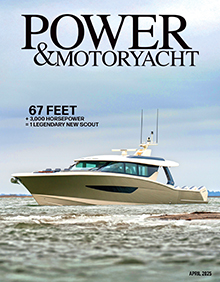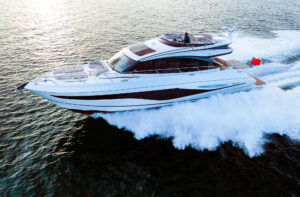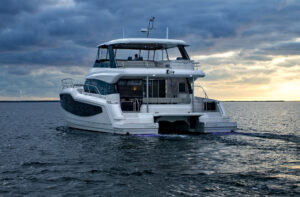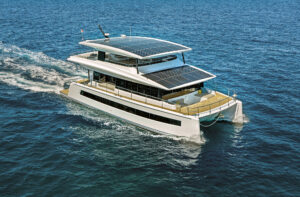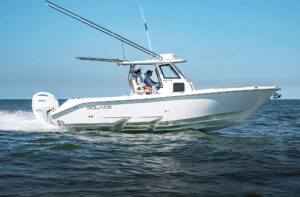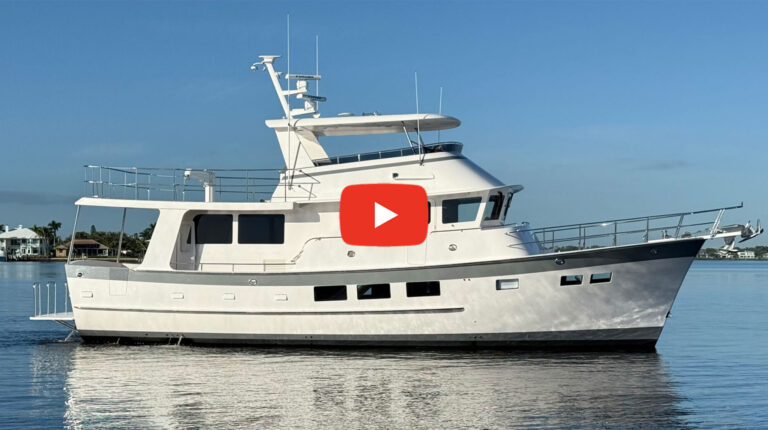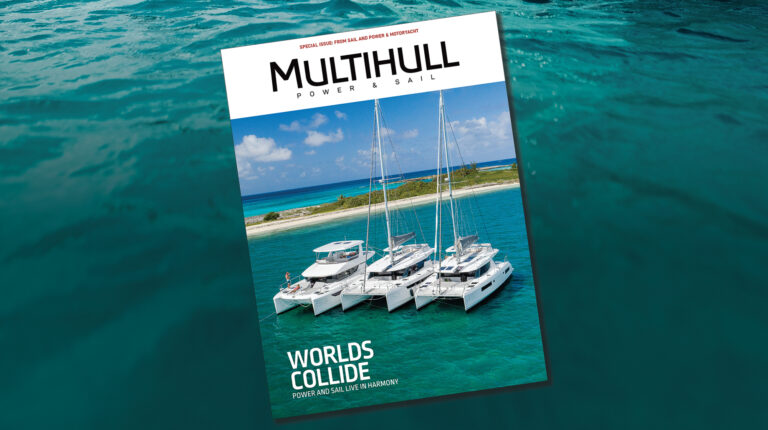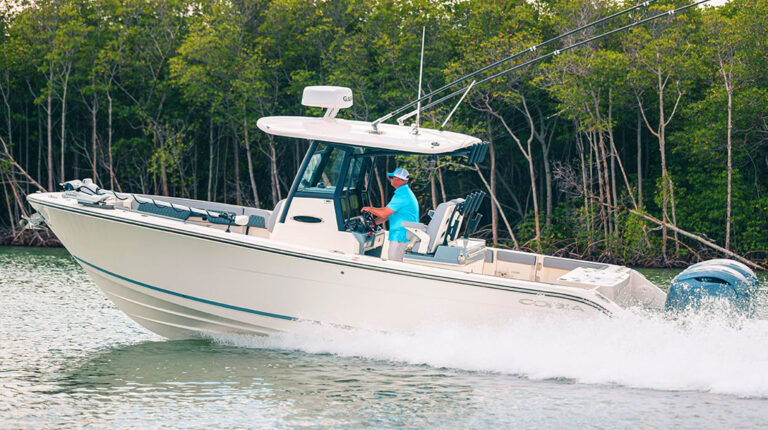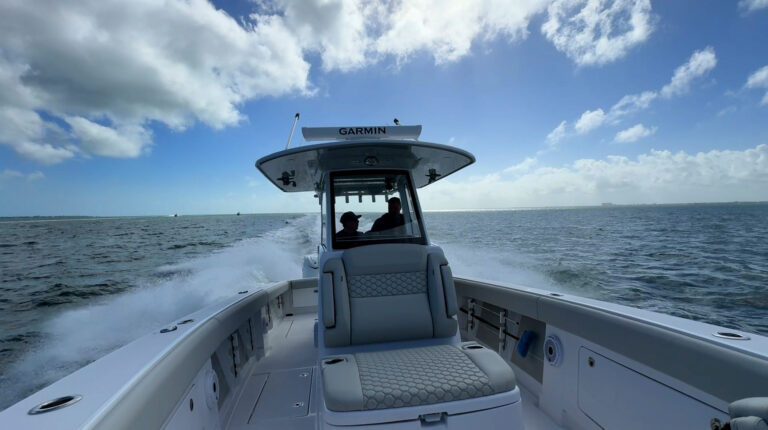Back from the Dead
The story of the restoration of the original Formula 233 The Cigarette is one that could change the face of historical boat collecting forever. Witness the rise of the “glassic.”

The annual Vintage Weekend at Key Largo’s luxurious Ocean Reef Club is a gathering of impressively restored boats, cars, and planes on display. And normally that’s more than enough to wow the crowd—but this year there was a surprise.
The entries in the nautical arena included the likes of a former presidential yacht from the ’30s, not to mention classic Trumpys, Chris-Crafts, Burgers, and Ryboviches lining the piers. All had their mahogany and teak varnished to a syrupy brilliance, their brass polished to a sparkle. Brilliant crystal ornamented the tables.
But the truly knowledgeable—the cognoscenti—among the boating visitors bypassed these opulent offerings and made a beeline to one boat, where they stood in awe, discussing her amongst themselves in hushed tones. What was this diamond among the jewels?
A small white plastic boat.
If you were a mouse eavesdropping on the comments, they ran something like this: “Can you believe it? That’s the boat that started it all!” or “So that’s where the name came from!” or “That was his very first boat!”

When one thinks of classics in the boating world, the word conjures up acres of varnish and a pedigree dating back to the early 1900s. This boat had barely enough wood to make a respectable cutting board. She was built just 50 years ago in 1963 and—egads!—she’s fiberglass.
So what was this magnet that caused such a stir? She was The Cigarette, a Formula 233 that was the debut fiberglass boat from Don Aronow’s first company, Formula Boats. Aronow, a wealthy real estate developer, had retired to Florida as a 33-year-old millionaire, where he was bitten by the offshore-powerboat racing bug. He entered a wooden raceboat in the 1962 Miami-to-Nassau Race but, after seeing a 17-foot racer co-designed by Jim Wynne (inventor of the sterndrive) and Walt Walters, he hired them to design a larger, fiberglass version.

The company was intended as a thinly disguised tax shelter for Aronow’s racing ambitions and there are two versions of the naming. The first is that when Wynne and Walters were discussing the plans with Aronow, he would ask them a technical question and one of the two designers would answer, “You know, there’s a formula for that.” According to Aronow’s son, however, the name was chosen because the combination of designers Wynne and Walters with fiberglass builders Buddy Smith and Jake Trotter was the “formula” for success. I like both choices.
The first hull out of the mold was a prototype, but Aronow grabbed the first production hull for racing, following the Detroit precept that “what wins on Sunday, sells on Monday.” He named her The Cigarette in honor of a successfully fast Prohibition-era rum runner of that name from his native New York. Entered in the Miami-to-Key West race, he proved the boat by winning his class, and actually finishing second overall to a much larger and more powerful racer. The boat, bearing Aronow’s lucky race number and The Cigarette name on the stern, returned to the shop and Aronow moved on to larger projects. Other 233 racers followed, however, with Wynne winning the Miami-Bimini-Miami race in a sistership.
The Formula 233 proved very successful, with production lasting more than 20 years and hundreds of boats. And, over the years, one editor noted that he could identify more than two dozen other boats built with lines stolen from the popular 233.

So where was The Cigarette, and how did it languish for so long before becoming the classic “barn-find” so cherished in the world of automobile restoration?
Aronow had sold The Cigarette to another budding racer, George Peroni, a few months after that first race. The boat carried a list price of $8,600 but, because Aronow had raced the boat, he discounted it to $6,090.
Shortly after the sale, however, Aronow called Peroni and asked to borrow the boat back for an afternoon, saying he had “some guys who want a ride in a fast boat.” Peroni loaned him the boat, and Aronow used it to take The Beatles out for their first speedboat ride just as they were about to become insanely famous in America.
Peroni eventually changed the boat’s name to Empirical and raced her from 1964 until 1972, filling his shelves with silverware including an overall win in the Gateway Marathon from Palm Beach to Grand Bahama and back. In the Gateway, he drove alone, standing for the entire three hours!
But ocean-racing equipment and speeds soon left the Formula behind and the boat was retired to family use. At one point, Peroni and his son decided to restore it, but tragedy struck first when his son was killed in a car accident. The boat was put in the backyard under a canvas cover and there it remained for decades.

Fast forward nearly 40 years from 1963 to 2002, when Bob DeNisco, Sr., visits his old friend, George Peroni who, along with Jim Wynne, had all gone to high school together in Miami and remained close over the years.
In Peroni’s backyard, DeNisco saw the very tired Formula 233, covered in mold and with a palm tree literally growing out of her. DeNisco remembered riding with Peroni on the boat decades earlier, when Peroni both raced it and used it as a pleasure boat. In classic barn-find style, DeNisco asked Peroni if he wanted to sell it and the two cut a deal: the “valuable consideration” for the sale was one dollar, but DeNisco had to promise to restore the boat.
And so Bob DeNisco, Sr., his sons Bob Jr. and Scott, and nephew John, launched a four-year project to revive the vintage racer. It was a small boat, but a major project that involved several companies. Bob Jr. recalls the restoration as “one step forward and two back” because they had to find missing parts or fabricate those pieces that couldn’t be found.

John DeNisco, whose Deno Marine builds sportfishers and flats boats, structurally restored the hull and deck, which had been reinforced with plywood before builders fully understood the effects of time and rot on a wood core.
The engine, which had been removed long before the DeNiscos acquired The Cigarette, was a wreck but it was also an incredible find. It was a Chevy 409 engine and more than a few Power & Motoryacht readers will remember The Beach Boys lyrics: “She’s real fine, my 409!” This particular 409 was one of just two marinized by Carl Kiekhaefer of Mercury Marine for racing and, when they stripped the valve covers, they found Kiekhaefer stamps underneath the paint.
But the engine pieces were in three shopping carts and when they delivered them to Innovation Marine of Sarasota, Florida, to rebuild, there was a long moment of silence. The legendary engine builder, led by Dave Stiff, hadn’t seen a 409 in 30 years.
The decision was made to make the powerplant bulletproof and, though the DeNiscos have the original sterndrive, they substituted a MerCruiser Bravo I drive for strength. Many of the engine parts were salvageable, including the original crankshaft and, with modern carburetion and headers, the engine punches out a reliable 425 horsepower on 87 octane pump gas. The finishing touch was finding some original Mercury decals for the engine.

At the same time, the boat was getting the full treatment from Rob Wilhoit at The Boathaus, which had to mold new parts, including hatches, and restore the teak trim. The original steering wheel was refurbished but Teleflex steering was substituted for safety. A new electrical harness was run, and the boat was thoroughly renewed including a PPG finish of the entire thing (including the bilges) that is flawless.
The original fuel tank of The Cigarette had a domed shape that extended through the cockpit floor, so the driver and companion were literally bracing against the tank. While that might have been original, it would hardly pass Coast Guard inspection today, so a newer (and lower) tank was installed.
Exactly four years to the day after they moved the boat from her backyard resting place, the DeNiscos launched The Cigarette for a test run. The original boat, outfitted with a two-bladed prehistoric prop, ran in the mid-40-knot range in 1973. In fact, Peroni’s average speed for the Gateway Marathon was just 29 knots! Today, the restored Formula hits nearly 56.
The DeNiscos entered The Cigarette in the Don Aronow Memorial Miami to Bimini Race in 2008, running the boat with George Peroni’s other son, Mark, along with Charlie McCarthy, founder of the Historic Offshore Race Boat Association (HORBA). With friends and Aronow family in attendance, The Cigarette won the historic production class and, though she finished long after the bigger and faster boats, several famous racers from the past lingered in a driving rainstorm to watch The Cigarette finish as a measure of their respect.
I was privileged to get a ride on The Cigarette and, in a world where even mildly fast speed boats have deeply bolstered seats and sophisticated instrumentation, she’s a tribute to the tough men of ocean racing in the early years, who would return bloodied and beaten—and often with broken arms or legs—from the pounding.
Standing unsupported while hanging onto the skinny automotive steering wheel or clutching the grab rail, I can’t imagine them hammering all the way to Nassau, holding on by sheer willpower and navigating with a compass from a World War II bomber. When the DeNiscos were restoring The Cigarette, they found a small hole near the throttle where Aronow and Peroni had used a shock cord to hold the throttle wide open while they hung on for dear life.
The Cigarette is a remarkable boat in many ways and her superb restoration—and huge acceptance at Ocean Reef—provokes some thoughts about collecting older boats. There is no question that fiberglass boats have now entered the realm of collectibles, but how fast—and how far—that hobby will grow is still unknown.

In the automotive world, the earliest existing Ferrari is worth somewhere in the $6,000,000 range, while Ferraris with racing provenance sell for twice that amount. A Shelby Cobra once owned by Carroll Shelby was auctioned for $5.5 million six years ago. A 1970 Plymouth Barracuda, of which thousands were built, sold for $2.1 million six years ago.
So what is The Cigarette worth on the collector market? Who knows? She’s the first Formula, the first Formula race boat, and the first fiberglass boat raced by Don Aronow, who went on to change performance boating forever. In addition, she carried The Beatles, and she is impeccably restored with one of two 409 marine engines. This one boat fairly shrieks the words, “historical significance,” which are so important to serious collectors.
The very idea boggles my mind, but it also makes me want to start looking a lot closer at those used-boat ads because, and this is my prediction, The Cigarette is just the tip of a new collector craze in historic boats. You can stop hunting for that Gar Wood or Chris-Craft under a tarp in a barn. Start prowling Craig’s List for classic glass, because “glassics” are here to stay!
Don Aronow discovered that his real “formula” was to design a good boat, race it successfully, make it a production model, sell the company for a profit, and then do it all over again. After Formula, Aronow started Donzi, followed by Magnum Marine and then Cigarette Racing Team (that name again!), Squadron XII, and finally USA Racing Team.
So that creates at least five more highly collectible “Aronow firsts,” and that doesn’t even tap into the other famous race boats of the era: Bertrams, Scarabs, Carys, and more.
But here’s the good news about restoring boats: it’s fun. The DeNiscos may have a historic race boat with a price that can’t be calculated, but they still take her for regular joy rides.
People stop them occasionally and, according to Bob Jr., actually get huffy about the name. “How dare you call that a Cigarette”, they say accusingly. “It’s a Formula!”
“No,” reply the DeNiscos with a grin. “It’s The Cigarette.”
Ticket to Ride

How’d that famous boat ride with The Beatles come about, and how did they like it? Well, The Beatles were in the United States for the first time making their historic appearances on The Ed Sullivan Show. On a day in between their first and second performances, the boys from Liverpool decided they wanted to have some fun, and were put in contact with Don Aronow—not surprising considering all of Aronow’s celebrity clients and contacts. The five men tooled around Miami for the day at speeds none of The Beatles had ever come close to on the water. By most reports, John Lennon, Paul McCartney, and George Harrison got a touch of seasickness. But Ringo Starr? He apparently had the time of his life. And that’s saying something when you’re a Beatle. Drummers; they really do have all the fun. For more on Aronow, see Kevin Koenig’s award-winning oral history, here ▶.

